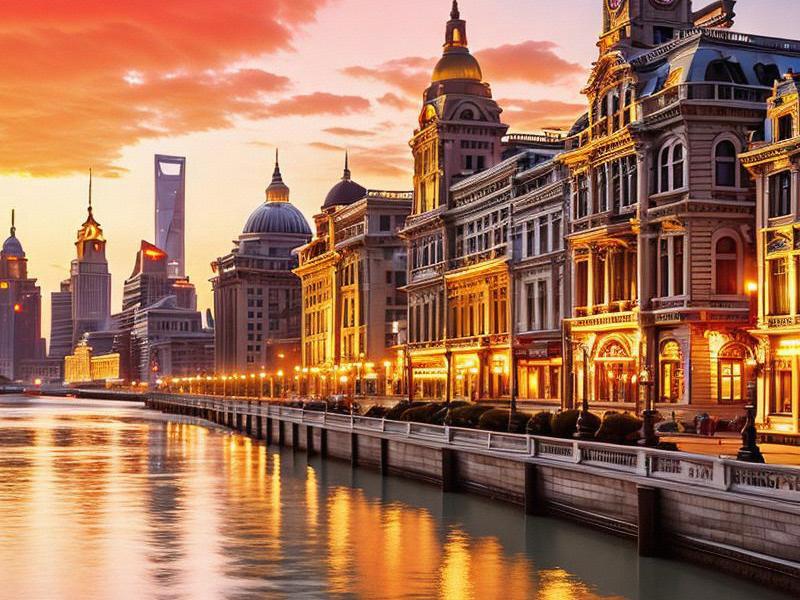The Cultural Charm of the Bund In Shanghai - An Exploration of Shanghai's Icons from Past to Present
⏱ 2025-04-21 00:00 🔖 阿拉爱上海千花网
📢0℃

Nestled along the Huangpu River in the heart of Shanghai, the Bund is not just a stretch of waterfront but a living testament to the city's storied past and dynamic present. This iconic waterfront promenade has witnessed the ebb and flow of history, from its colonial origins to its current status as a symbol of Shanghai's cultural and economic prowess.
The Bund, known in Chinese as Wai Tan (外滩), literally means "Outer Bank," was originally a British settlement in the 19th century. It was here that the city's most striking architectural ensemble was born, a blend of Gothic, Baroque, Romanesque, and neoclassical styles that came to define the area. These buildings, many of which now house financial institutions, stand as a visual chronicle of Shanghai's colonial history and its role as a global trade hub.
The architectural splendor of the Bund is perhaps its most defining feature. The Customs House, with its grand clock tower, is a particularly notable structure. Built in 1927, it served as the headquarters for the Chinese Maritime Customs Service and is a prime example of the Beaux-Arts style. The HSBC Building, with its intricate façade and clock tower, is another architectural gem that hails from the 1920s. These buildings, along with many others, have been meticulously preserved, offering visitors a glimpse into the past while standing as a testament to the city's commitment to maintaining its historical heritage.
The Bund's transformation over the years reflects Shanghai's evolution from a colonial port city to a global metropolis. In the late 20th century, as Shanghai underwent rapid economic reforms, the Bund was revitalized. The once derelict buildings were restored, and the area was transformed into a vibrant waterfront promenade. Today, the Bund is a popular destination for both locals and tourists, offering stunning views of the Pudong skyline, which includes the iconic Oriental Pearl Tower and the futuristic Shanghai Tower.
夜上海419论坛
The contrast between the historic Bund and the modern skyscrapers of Pudong across the river is one of the most striking features of Shanghai. Pudong, which was a rural area just a few decades ago, has been transformed into a symbol of China's economic rise. The juxtaposition of the old and the new is a metaphor for Shanghai itself—a city that seamlessly blends its rich history with cutting-edge modernity.
The cultural significance of the Bund extends beyond its architecture. It is a place where history and culture converge, offering a stage for various events and exhibitions. The annual Shanghai International Film Festival, for instance, often features outdoor screenings on the Bund, drawing large crowds to enjoy the films against the backdorpof the historic buildings. The area also hosts numerous art exhibitions, concerts, and other cultural events, making it a vibrant cultural hub.
In recent years, the Bund has also become a focal point for sustainable urban development. The Bund Greenway, a 2.7-kilometer-long pedestrian and cycling path, was completed in 2017. It offers a scenic route along the waterfront, complete with green spaces, seating areas, and art installations. This initiative not only enhances the quality of life for residents but also promotes environmental sustainability.
上海水磨外卖工作室
The Bund's role in Shanghai's identity is not just about its historical and architectural significance. It is also a symbol of the city's resilience and adaptability. From a colonial outpost to a global financial center, Shanghai has continually reinvented itself, and the Bund stands as a reminder of this journey.
The Bund's cultural charm is further enriched by the stories of the people who have lived and worked there. Many of the buildings on the Bund have witnessed significant historical events, from the signing of treaties to the rise and fall of political regimes. These stories add a layer of depth to the area, making it more than just a collection of buildings but a living, breathing entity that tells the story of Shanghai.
Tourists visiting the Bund can experience its cultural charm through guided tours, which provide insights into the area's history and architecture. The Shanghai Bund Museum, located within the Customs House, offers an in-depth look at the area's past, with exhibits ranging from historical photographs to artifacts. For those interested in art, the Bund 18, a former bank building, has been converted into a contemporary art gallery, showcasing works by both local and international artists.
上海品茶论坛
The Bund's influence extends beyond Shanghai, serving as an inspiration for other cities undergoing urban renewal. Its successful transformation from a derelict area to a vibrant cultural and economic hub demonstrates the potential of preserving historical landmarks while embracing modern development.
In conclusion, the Bund in Shanghai is much more than a waterfront promenade; it is a symbol of the city's rich history, architectural beauty, and cultural vibrancy. Its transformation over the years reflects Shanghai's evolution as a global metropolis, and its cultural charm continues to attract visitors from around the world. The Bund stands as a testament to the city's ability to blend its past with its future, offering a unique perspective on the story of Shanghai.
As Shanghai continues to grow and evolve, the Bund will undoubtedly remain a central part of its identity. Its preservation and continued development are a testament to the city's commitment to honoring its history while embracing the future. The Bund is not just a place to visit; it is a living museum that tells the story of Shanghai in all its complexity and beauty.
Shanghai’s Gilded Lounges: Where Art Deco Opulence Meets AI-Curated ExtravaganceThe Great Shanghai Convergence: How the Mega-City Is Reshaping the Yangtze Delta Region"Code and Qipao: How Shanghai's Women Are Rewriting the Rules of Modern Femininity"The Yangtze River Delta Megaregion: Shanghai's Bold Vision for Integrated Urban Future《海派丽人启示录:上海女性审美变迁与都市文化演进》弄堂里的"新主人":上海城市更新中的社区共生与文化新生Shanghai's Nocturnal Revolution: How the City Redefines Luxury Entertainment《从"百乐门"到"数字包厢":解码上海娱乐会所的百年进化史》文章开始Shanghai's Beauty: A Blend of Tradition and ModernityShanghai 2045: The Living Laboratory of Urban Futurism

